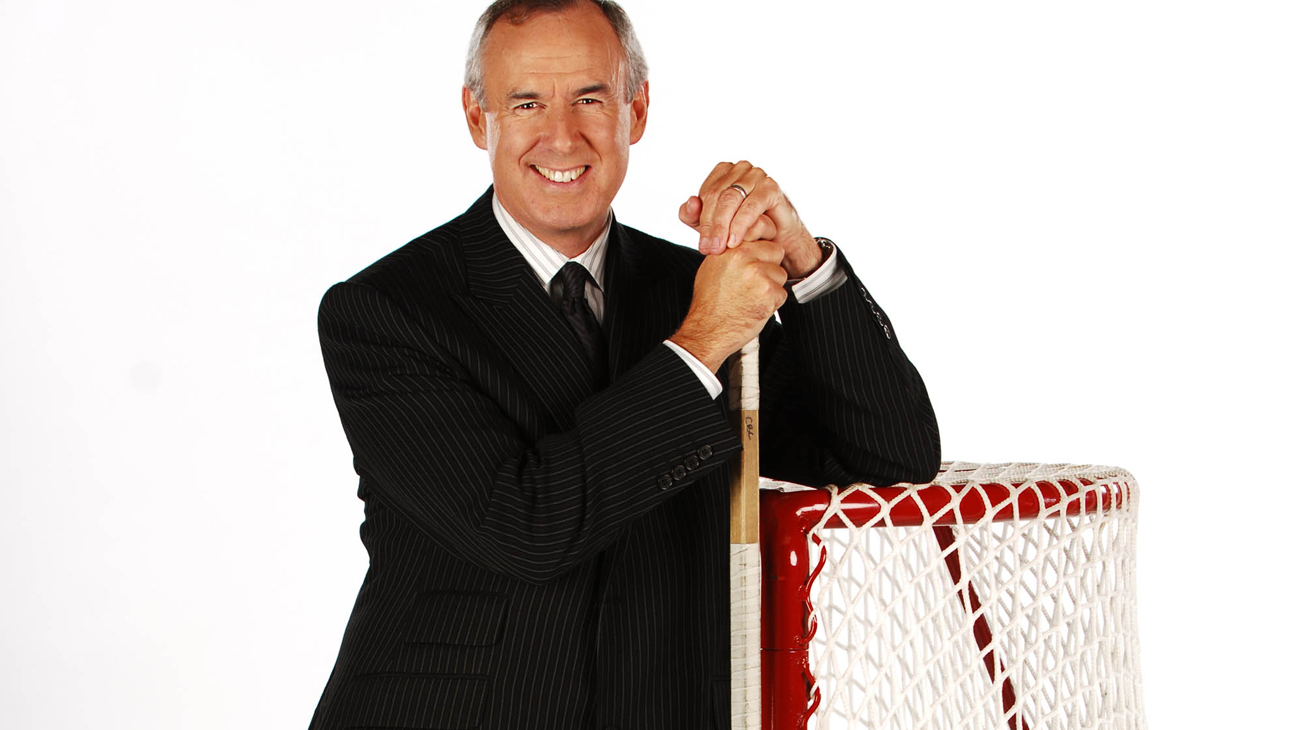Watching Ron MacLean has been a Canadian tradition for twenty-five years. Known for his quick wit and encyclopedic hockey knowledge, MacLean reaches millions of homes across the country on Canada’s most watched weekly program, Hockey Night in Canada, and as the host of Hometown Hockey. He has interviewed the greatest players, coaches, and personalities in the sport and is a master of seeking the best in substance and entertainment from his guests, as well as from his opinionated and often irascible co-host on Coach’s Corner, Don Cherry. As a speaker or emcee, Ron’s thoughtful insights, thrilling stories, and engaging style will entertain audiences from coast to coast. Olympian Adam Kreek caught up with Ron to talk to him about how he handles his gruelling schedule while on the road:
Ron MacLean knows how to handle the stresses of constant travel and late nights (not to mention Don Cherry’s impulsive commentary). But give the host of Coach’s Corner a freaked-out five-year-old, and he falls apart.
I took MacLean out rowing and crab fishing in some larger-than-average waves off the southern coast of Vancouver Island a few weeks ago. My five-year-old son was with us, and although we were perfectly safe, the little guy got scared, wet and cold. MacLean doesn’t have any kids, and the screaming youngster became hard for him to handle. He awkwardly tried to comfort my son as he pulled harder and harder on his oars to get us ashore as soon as possible.
Back on land, warm and dry, we laughed about the tense 10 minutes we shared with my screaming boy. As expected, MacLean handled it gracefully. He has always relied on exercise to beat back the stresses of his life and career: Jet lag from constantly zipping across time zones, late nights at hockey arenas, and compensating for Don Cherry’s at-times-inappropriate comments.
Ron’s recipe
“It starts and ends with exercise,” said MacLean, who was recently announced as host of CBC’s Olympic Games Morning for Rio 2016. “I try to balance cardio and weights. I especially try to do weight training three times a week. It gives me this belief that I am going to handle the jet lag.”
What about nutrition and diet? MacLean regularly takes concentrated ginseng, among other supplements. “I like to bring my vitamins. I like powdered greens. Maybe it’s psychological, but I try to adhere to the right nutrients.”
Training to avoid injury
I was curious about MacLean’s training program and what the rest of us could learn from it. So I called up his personal trainer, Karen Finnell, at the Oakville Club, just west of Toronto.
“Ron is strong and determined,” Finnell said. “What makes Ron successful is his commitment. You have to commit to the long term.”
MacLean started working with Finnell in 2003 because he was suffering from shoulder pain. Finnell said his main goal in using a personal trainer is to stay injury-free for his rec hockey league, and to live an active life. He has achieved this by embracing what Finnell calls the three “companions” of fitness: resistance (weights), cardiovascular training (for the heart and lungs), and flexibility/balance (to prevent injury).
Whether he’s playing and refereeing hockey or rowing and fishing with Olympic has-beens, MacLean simply enjoys getting out there. “There is always a way to exercise. Creativity is such an element of it. It’s not so much to be a slave to the clock. You can be stuck in the rut of thinking, ‘I need 30 minutes of this, or an hour of that,’ but time is immaterial when you make time for exercise 24/7.”
Tips from MacLean’s trainer
1. Warm up: Forget the treadmill. Start any workout with exercises that work multiple joints. “Mountain Climbers” are a good example.
2. Push and pull: Exercise muscles that balance each other to ensure that your body does not become susceptible to injury. Start with exercising your lower-body. For legs and butt, do lunges and squats. For back and chest, alternate push-ups with Supermans. For biceps and triceps, mix curls and dips.
3. Make core the core: Core strength is the centre of all physical power. It ensures that your back will be pain free, and tightens up your body to prevent injuries to the extremities. Sample exercise: Plank.
4. Pursue proper technique: Injuries happen when we load up too much weight and struggle through a lift. Don’t be that grunting, contorted guy at the gym with too much weight on the bar. Instead of striving for maximum weight, strive for perfect motion. Ensure that you can take each exercise through a full range of motion before you add weight. This makes your fitness more functional.
5. First fatigue, then Failure: I know I told you to “Seek Failure” in my TEDx talk, but Karen Finnell’s advice is more nuanced. When starting a weight routine, or starting up after some time off, take it easy. We don’t want to injure our muscles, joints, tendons or ligaments. Use a lower weight with more reps to push your body to fatigue. After a couple weeks, you can raise the weight, lower the reps and seek failure to experience more strength gains. Make sure you use a spotter.
6. Legs before bench: Too many guys walk into the weight room and go straight to the bench press — and end up looking like a cartoon lion tamer. Your glutes, hamstrings and quads are your biggest muscle groups, and working them stimulates testosterone production, which will also boost upper body growth. Try wall squats to train your testosterone producing pistons.
Adam Kreek/CBC.CA/March, 2016

